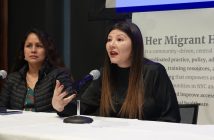NEW YORK (Oct. 30, 2003) —New York City’s Department of Education distributes its resources inequitably along race and poverty lines, directly affecting student behavior and administrative actions against students, according to a study released today by Fordham University’s National Center for Schools and Communities (NCSC).
The study, “Equity or Exclusion: The Dynamics of Resources in New York City Public Schools,”is the first analysis and documentation of a close connection between educational resources and behavioral indicators, such as attendance and suspensions, in the New York City Public Schools. The results where shared during a news conference at the Lincoln Center campus.
The study “provides yet another confirmation of the fact that we are still a long way from having public schools that offer students an equal chance for a good education,” said John M. Beam, executive director of the NCSC. He added, “The growing weight of this evidence will reach a tipping point at which the court of public opinion, if not the Supreme Court, will rule that allowing the continued maldistribution of the essentials of good education is an intentional assault on the rights of those students.”
After Michael Eskenazi, the principal investigator for the study, outlined the report’s results during the news conference, advocates for education reform, including New York City Councilwoman Gale Brewer, offered real-life examples of the problems depicted in the study.
The study found that, in general, schools with higher enrollments of black, Hispanic, and free-lunch eligible children have fewer library and computer resources, less qualified teachers, and fewer course and enrichment offerings. Schools with inadequate
resources are more likely to have higher suspension and absentee rates and they are more likely to have more black and Hispanic students. Schools with greater resources and higher concentrations of white and Asian students experience lower percentages of suspensions, across all racial groups.
“What this all comes down to is a question of the carrot versus the stick,” Eskenazi said. “Are we going to invest in resources that engage students and encourage them to come to school, or are we going to try to solve all of the public schools’ problems with security guards and metal detectors?”
Jill Chaifetz, the executive director of Advocates for Children, said a majority of her clients are black and Hispanic males. Many of her clients are also children with disabilities, a group that receives a disturbingly disproportionate number of school suspensions. In the 1999-2000 school year, children receiving special education services represented approximately 43 percent of all superintendent suspensions, which could last as long as one year, yet they only account for approximately 11 percent of the student register in the New York City school system.
“Even when we get the suspensions dismissed, these students have already been out of school for days and they are behind,” Chaifetz said. “It’s a downward spiral. … This issue needs to be addressed as the systemic problem that it is.”
The study, which was delivered to New York City Schools Chancellor Joel I. Klein, includes a number of recommendations for tracking and publicizing both discipline patterns and resource distribution in the public schools. The complete study is posted on the NCSC website at www.NCSCatFordham.org.
The National Center for Schools and Communities is a policy advocacy institute co-sponsored by the Fordham University Graduate Schools of Education and Social Services. The NCSC provides policy and data analysis to parent and community organizations working for public school reform.
Study Critical of Inequitable Resources in NYC Schools
0
Share.


